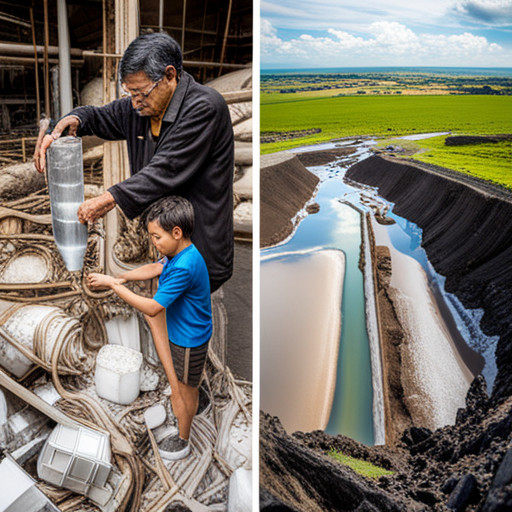PCE and TCE Contamination Causes and Health Risks
Perchloroethylene (PCE) and trichloroethylene (TCE), ubiquitous contaminants in industrialized societies, pose significant health risks.

This article investigates their sources, accumulative behavior in the environment, symptoms upon exposure, and governmental regulations to manage them.
It also explores current detection methods, and treatment strategies, and presents case studies of major contamination incidents, providing a comprehensive understanding of these hazardous substances and their impact on human health.
Key Takeaways
- PCE and TCE contamination can occur through various sources such as industrial waste discharge, improper disposal, leaks from storage tanks, and chemical manufacturing plants.
- Exposure to PCE and TCE can lead to serious health risks including liver damage, kidney dysfunction, increased risk of certain types of cancer, fertility complications, neurological disorders, and immune system disruption.
- Detection methods for PCE and TCE contamination include analytical techniques like gas chromatography and mass spectrometry, as well as monitoring of air, soil, and water samples.
- Treatment strategies for PCE and TCE contamination involve remediation techniques such as activated carbon filtration and soil vapor extraction, as well as the development of alternative solvents like water-based cleaning systems and supercritical carbon dioxide.
Understanding PCE and TCE Contamination

Understanding PCE and TCE contamination requires a comprehensive examination of the sources of these chemicals, their pathways in the environment, and the mechanisms of their toxic effects on human health.
PCE (Perchloroethylene) and TCE (Trichloroethylene) are chlorinated solvents primarily used in dry cleaning, degreasing and other industrial applications. Release of these chemicals into the environment commonly occurs through industrial waste discharge, improper disposal, and leaks from storage tanks.
The contamination pathways of PCE and TCE are complex, often involving air, soil, and water mediums. Once released into the environment, these chemicals can volatilize into the air, infiltrate into groundwater or adsorb onto soil particles. Human exposure can occur through inhalation, ingestion of contaminated water, or direct contact with contaminated soil.
Prolonged or high-level exposure to PCE and TCE has been associated with serious health effects including liver damage, kidney dysfunction, and an increased risk of certain types of cancer. The toxic mechanisms are multifaceted, involving metabolic activation of the chemicals into more toxic metabolites that can bind to cellular proteins and DNA, leading to cellular damage and potential carcinogenesis.
Given the environmental persistence and health risks associated with PCE and TCE, considerable efforts have been made to identify PCE alternatives and TCE replacement options. These include water-based cleaning systems, supercritical carbon dioxide, and other less toxic solvents. However, the effectiveness, feasibility, and safety of these alternatives need to be assessed comprehensively to ensure they are viable substitutes for PCE and TCE in various applications.
The Role of Industrial Activities in PCE and TCE Contamination

The role of industrial activities in PCE and TCE contamination presents a multifaceted issue. Key areas of focus include the identification of industrial sources of contamination, the assessment of exposure in workplaces, and an examination of the challenges surrounding regulation and compliance.
Industrial processes are known to be a significant source of PCE and TCE, pollutants which pose substantial health risks. It is crucial, therefore, to scrutinize the regulatory frameworks and compliance issues that govern the safe handling and disposal of these hazardous substances. This is necessary in order to mitigate exposure risks in the workplace and the wider environment.
Industrial Sources of Contamination
Industrial sources of contamination, such as chemical manufacturing plants and dry cleaning facilities, significantly contribute to the prevalence of PCE and TCE in the environment. Contamination prevention strategies are vital in these industries to reduce environmental impact.
- Chemical manufacturing plants:
- Use of alternative solvents to PCE and TCE
- Implementation of advanced filtration systems
- Dry cleaning facilities:
- Transition to water-based or CO2 cleaning technologies
- Proper disposal of waste solvents
These measures can effectively limit the release of harmful compounds. By adopting alternative solvents, industries can reduce the risk of contamination. Furthermore, improved disposal practices and use of modern cleaning technologies can significantly reduce the presence of PCE and TCE in the environment.
Exposure in Workplaces
Exposure to harmful compounds in workplaces, particularly those involved in chemical manufacturing and dry cleaning, necessitates stringent safety measures and monitoring to control potential hazards. Workplace policies should enforce the use of personal protective equipment, regular health screenings, and appropriate ventilation systems.
Employee protection is paramount, and potential risks of exposure to contaminants such as PCE (Perchloroethylene) and TCE (Trichloroethylene) cannot be overlooked. Each bears severe health risks including respiratory problems, kidney malfunction, and potential carcinogenic effects.
It is critical for industries to maintain an acceptable concentration of these compounds in the working environment, adhering to the permissible exposure limits (PEL) set by regulatory bodies such as the Occupational Safety and Health Administration (OSHA).
Thus, the importance of rigorous safety protocols and monitoring cannot be overstated.
Regulation and Compliance Issues
Regulation and compliance issues present significant challenges, requiring industries to adhere strictly to standards set by regulatory bodies to protect workers from potentially hazardous substances. Such regulations are enacted after thorough policy development, and noncompliance can lead to detrimental legal repercussions.
- Legal Repercussions:
- Severe fines
- Legal suits
- Operational license revocation
Policy Development:
- Extensive research and studies
- Stakeholder consultation
- Implementation and monitoring
Failure to comply with these regulations not only jeopardizes the health and safety of the workforce but also incurs substantial economic costs. Therefore, it becomes essential for industries handling hazardous substances like PCE and TCE to ensure strict adherence to regulatory standards, thereby minimizing the risk of contamination and ensuring worker safety.
Household Products and PCE and TCE Exposure

Common household products such as adhesives, spot removers, and typewriter correction fluid can contain PCE and TCE, thus posing potential health risks. These risks are often unknown to the general public, as these chemicals are not typically listed on the product labels. PCE, also known as tetrachloroethylene, and TCE, trichloroethylene, are volatile organic compounds (VOCs) that are classified as potential human carcinogens.
PCE is commonly found in cosmetics and personal care products. It acts as a solvent and a degreaser, making it useful in products such as nail polish removers and hair sprays. However, the use of PCE in these products can lead to direct inhalation or skin absorption, both of which pose significant health risks.
Similarly, TCE is widely used in household cleaners due to its effective degreasing properties. It is present in carpet cleaners, kitchen degreasers, and even some laundry detergents. Exposure to TCE can occur through inhalation, skin contact, or accidental ingestion, particularly in poorly ventilated areas or during prolonged use of products containing the substance.
Exposure to both PCE and TCE has been linked to various health issues, including liver and kidney damage, impaired immune system function, and increased risk of certain types of cancer. Despite these known risks, the use of PCE and TCE in household products remains widespread. This underscores the need for greater public awareness and stricter regulations to reduce exposure and protect public health.
Bioaccumulation of PCE and TCE in the Environment

The process of bioaccumulation, specifically relating to perchloroethylene (PCE) and trichloroethylene (TCE), involves the gradual accumulation of these chemicals in an organism's tissue, often at a rate faster than they can be metabolized or excreted.
This phenomenon has significant implications for ecosystems, as it can lead to biomagnification, a process where the concentration of these toxic substances increases as it moves up the food chain, exerting detrimental effects on multiple levels of the ecosystem.
Furthermore, the bioaccumulation of PCE and TCE presents various health risks to both wildlife and humans, including potential carcinogenic effects and damage to the central nervous system, which warrants further investigation and discussion.
Bioaccumulation Process Explanation
Bioaccumulation refers to the gradual accumulation of substances, such as pesticides or other chemicals, in an organism. This process can have significant impacts on both individual organisms and broader ecosystems.
Bioaccumulation prevention is crucial to maintaining ecosystem resilience. Strategies include:
- Reducing the use of toxic chemicals in industry and agriculture.
- Improving waste management practices to prevent chemical leaks into the environment.
The resilience of an ecosystem is its ability to recover from disturbances such as chemical contamination. Aspects of ecosystem resilience impacted by bioaccumulation include:
- Biodiversity: High levels of bioaccumulation can reduce species diversity, weakening the ecosystem.
- Food chain integrity: Accumulated toxins can move up the food chain, impacting predators and potentially leading to local extinctions.
Thus, understanding and mitigating bioaccumulation is key to preserving ecosystem health.
Impact on Ecosystems
In relation to the bioaccumulation process, the subsequent impacts on ecosystems and their resilience cannot be overstated. Ecosystem resilience refers to the capacity of an ecosystem to tolerate disturbance without collapsing into a qualitatively different state.
PCE and TCE contamination challenges this resilience, altering the balance of species within an ecosystem. This imbalance can lead to species vulnerability, a concept that encapsulates the risk that a species may become extinct in the wild. The vulnerability arises from changes in environmental conditions or specific destructive events.
In the context of PCE and TCE contamination, species vulnerability can be heightened as these contaminants infiltrate food chains, affecting organisms at different trophic levels. Therefore, understanding this impact is crucial for the future management of ecosystems.
Health Risks Concerns
Exposure to certain pollutants can lead to serious consequences for both human and animal populations, raising grave concerns related to wellbeing and survival. Contaminated food risks are a key concern. Consumption of tainted food can result in serious health complications.
- PCE/TCE effect on animals:
- Chronic exposure may lead to liver, kidney or lung damage.
- Reproductive disorders have also been noted.
- Risks associated with contaminated food:
- Ingestion of harmful substances may trigger acute or chronic illnesses.
- These include cancers, neurological disorders, and immune system disruption.
Thus, it is crucial to address issues of contamination promptly and efficiently. This will not only safeguard the health of animal populations but also ensure the wellbeing of humans, who are ultimately at the top of the food chain.
Identifying Symptoms of PCE and TCE Exposure

Recognizing the signs of PCE and TCE exposure includes symptoms such as dizziness, headaches, and changes in mood or sleep patterns. These hazardous chemicals are often encountered in industrial and residential settings, and exposure can occur through various routes. For PCE, common exposure routes include inhalation, skin contact, and ingestion from contaminated water or soil. Likewise, TCE exposure can occur through similar routes, with inhalation being the most common due to its prevalent use as a solvent in industries.
| PCE Exposure Routes | TCE Detoxification Methods | |
|---|---|---|
| Route 1 | Inhalation | Ventilation |
| Route 2 | Skin Contact | Bioremediation |
| Route 3 | Ingestion | Activated Charcoal |
Detoxification methods for TCE include ventilation, bioremediation, and the use of activated charcoal. Ventilation, both of the environment and the individual, helps to rid the body of the chemical. Bioremediation involves the use of microbes to break down the compound, while activated charcoal can bind to the chemical, preventing its absorption in the body.
Long-Term Health Effects of PCE and TCE Exposure

Long-term exposure to perchloroethylene (PCE) and trichloroethylene (TCE), two common environmental pollutants, has been linked to a myriad of negative health outcomes.
Research indicates a correlation between chronic exposure and an elevated risk of certain types of cancer, including but not limited to renal cell carcinoma and non-Hodgkin lymphoma.
Additionally, these substances may have detrimental effects on the neurological and reproductive systems, manifesting in symptoms such as cognitive dysfunction, mood changes, and fertility issues.
Cancer Risk Increase
Studies have shown a significant correlation between PCE and TCE contamination and an increased risk of developing various forms of cancer. The escalation in risk is not universal and appears to be influenced by several factors such as genetic predisposition and lifestyle factors.
* Genetic predisposition
* Certain genetic profiles may predispose individuals to a higher susceptibility to the carcinogenic effects of these chemicals.
* Lifestyle factors
* Behaviors' such as smoking, alcohol consumption, and poor diet may exacerbate the impacts of PCE and TCE exposure.
Thus, the interplay of these factors with PCE and TCE contamination could lead to a heightened cancer risk. It is critical to further investigate these relationships to inform preventive strategies and risk mitigation efforts.
Neurological Impact
Exposure to certain environmental toxins has been linked to adverse neurological effects, highlighting the need for further research into this complex relationship. A particular focus has been on the neurological impact of PCE and TCE, common environmental contaminants.
Research suggests that PCE's genetic impacts may lead to neurodevelopmental disorders, including Autism and Attention Deficit Hyperactivity Disorder. Concurrently, TCE's psychological effects are under scrutiny, with studies indicating potential links to mood disorders and impaired cognitive function. The exact mechanisms behind these impacts remain unclear, necessitating further exploration.
Understanding these processes could significantly enhance strategies for preventing and mitigating the neurological consequences of PCE and TCE exposure.
Reproductive System Effects
Potential implications on the reproductive system due to environmental toxins have raised critical concerns among the scientific community. Research indicates that contamination by PCE and TCE could lead to fertility complications and genetic mutations.
PCE and TCE exposure has been associated with:
- Fertility complications:
- In males, decreased sperm quality and count, leading to infertility
- In females, hormonal imbalances causing irregular menstrual cycles and difficulty in conceiving
- Genetic mutations:
- Damage to the DNA in reproductive cells, potentially leading to inherited genetic disorders
- Increased risk of chromosomal abnormalities in offspring, potentially causing developmental and health issues
The objective, fact-based evidence suggests that these environmental toxins could have far-reaching effects on reproductive health, affecting not only current but also future generations.
The Link Between PCE, TCE and Cancer

Long-term intake of PCE and TCE has been strongly associated with an increased risk of developing certain types of cancer, such as liver cancer and non-Hodgkin lymphoma. This is largely attributed to PCE's chemical properties and TCE's commercial uses.
PCE, known scientifically as tetrachloroethylene or perchloroethylene, is a volatile organic compound that is highly stable and non-flammable. It is commonly used in dry cleaning and textile processing industries.
On the other hand, TCE, or trichloroethylene, is widely used as a solvent for cleaning metal parts in various industrial applications. Its volatility and ability to dissolve a wide range of organic materials make it a preferred choice in many industries. However, these properties also contribute to its pervasive presence in the environment and potential for human exposure.
Studies have demonstrated a positive correlation between prolonged exposure to these chemicals and increased cancer risk. The carcinogenic potential of PCE and TCE can be attributed to their metabolites, which are bioactive and can induce DNA damage, disrupting the normal cell cycle and leading to uncontrolled cell proliferation, a hallmark of cancer.
Notably, the International Agency for Research on Cancer (IARC) has classified TCE as a human carcinogen and PCE as a probable human carcinogen. The liver, the primary site for the metabolism of these compounds, and the lymphatic system, a route of excretion for their metabolites, are particularly vulnerable to their carcinogenic effects.
Consequently, liver cancer and non-Hodgkin lymphoma are among the most common cancer types associated with PCE and TCE exposure.
The Impact on Children’s Health

Investigation into the impact of environmental contaminants on children's health has revealed significant correlations with growth impairment, cognitive development issues, and increased risks of childhood cancers.
Research has elucidated the detrimental effects of these pollutants on physical growth, leading to stunted development and other related health complications.
Furthermore, studies have indicated a potential causative link between these contaminants and cognitive development problems, along with an elevated risk of developing certain types of cancer during childhood.
Contaminants’ Effects on Growth
Exposure to PCE and TCE contaminants has been found to adversely affect growth in both humans and animals. The agricultural implications are profound, with these contaminants having the potential to hinder the growth and development of crops. Furthermore, research suggests that these contaminants may cause genetic alterations in organisms exposed to them. This can result in long-term changes to the species affected.
- Agricultural implications:
* Decreased crop yield
* Impaired plant health and vitality
- Genetic alterations:
* Changes in gene expression
* Potential for mutations
Both PCE and TCE are widespread environmental contaminants that pose significant risks to both human and ecological health. Therefore, understanding their impacts and developing strategies for mitigation is of utmost importance.
Impaired Cognitive Development
Impaired cognitive development in humans and animals has been associated with the presence of certain environmental pollutants. Studies have postulated that exposure to chemicals such as PCE and TCE can potentially alter the cognitive development in children, thereby leading to learning difficulties and behavioral issues.
Intervention strategies have been suggested to mitigate these effects and improve cognitive outcomes. Parental education has been identified as a key determinant of children's cognitive development. By enhancing parents' understanding of the risks associated with environmental pollutants, it can lead to necessary lifestyle modifications. These can include avoiding exposure to contaminated areas and ensuring a safe and healthy living environment.
These measures are critical in ensuring optimal cognitive development in children despite the presence of environmental pollutants.
Childhood Cancer Risks
Childhood cancer risks have been linked to a variety of factors, including genetic predisposition and environmental influences, warranting further research into preventative measures. Pediatric oncology studies have established correlations between exposure to certain environmental contaminants and increased incidence of specific types of cancers in children.
- Genetic predispositions
- Certain hereditary conditions can increase the risk of developing childhood cancers.
- Genetic mutations can be passed from parents to their children, predisposing them to cancer.
- Environmental influences
- Exposure to certain chemicals and radiation can increase cancer risks.
- Prolonged exposure to PCE and TCE contaminants can lead to the development of various childhood cancers.
Further research is necessary to establish clear connections and develop effective preventative measures. These findings underscore the importance of vigilant monitoring and regulation of environmental contaminants to safeguard children's health.
PCE and TCE Contamination in Drinking Water

Contamination of drinking water with PCE (Perchloroethylene) and TCE (Trichloroethylene) has been identified as a significant public health concern due to the potential carcinogenic effects of these chemicals. Exposure to these toxins often results from the consumption of contaminated groundwater, a common source of drinking water in many communities. As a result, ensuring the effectiveness of water filtration systems and implementing contamination prevention measures is crucial.
Water filtration systems designed to remove PCE and TCE have seen varying levels of success. Activated carbon filters, for example, have been able to reduce these contaminants significantly. Meanwhile, other filtration methods like reverse osmosis and distillation have shown inconsistent results.
| Water Filtration Method | Effectiveness in Removing PCE and TCE |
| Activated Carbon Filter | High |
| Reverse Osmosis | Variable |
| Distillation | Variable |
Contamination prevention measures are an essential part of maintaining safe drinking water. These include regular monitoring of water sources for PCE and TCE presence, proper disposal of these chemicals, and implementation of policies to prevent illegal dumping.
Furthermore, the identification of potential sources of contamination such as industrial sites, dry cleaning facilities, and waste disposal sites is crucial. Regular inspection and maintenance of water delivery infrastructures can also prevent contamination. Ultimately, the protection of public health necessitates a comprehensive approach that combines both effective water filtration and stringent contamination prevention measures.
PCE and TCE in Soil and Air

Exposure to Perchloroethylene (PCE) and Trichloroethylene (TCE) is not limited to water sources, as these volatile organic compounds can also be found in soil and air. PCE and TCE are commonly used in industrial processes and can leach into the soil and air from numerous sources, including improper disposal, leaks from storage tanks or transfer pipes, and atmospheric emissions from industrial operations. This widespread contamination poses an increased risk for direct exposure and inhalation, leading to potential health risks.
Contamination prevention and remediation techniques are crucial in managing the risk posed by these volatile organic compounds.
- Contamination prevention involves:
- Implementing rigorous controls on the storage, use, and disposal of PCE and TCE to prevent leaks and spills.
- Routine monitoring of industrial facilities to detect any uncontrolled releases into the environment.
- Remediation techniques include:
- Soil vapor extraction or air sparging to remove PCE and TCE from the soil.
- Bioremediation, which utilizes microorganisms to break down these compounds into less harmful substances.
The effectiveness of these techniques depends on several factors such as the extent of contamination, compound concentration, and local environmental conditions.
The global scale of PCE and TCE contamination requires a robust approach towards prevention and remediation. In addition to local initiatives, international cooperation is necessary to develop and enforce stringent regulations on the industrial use of these compounds. This will contribute to a safer environment and reduce the health risks associated with exposure to PCE and TCE.
The Role of Government Regulations in PCE and TCE Management

Government regulations play a pivotal role in managing the use and disposal of volatile organic compounds to prevent environmental harm. These regulations are aimed at controlling the emission of harmful substances, such as perchloroethylene (PCE) and trichloroethylene (TCE), that pose significant health risks to humans and detrimental effects to the environment.
However, regulatory loopholes often undermine the effectiveness of these regulations. For example, certain industries may be exempt from specific regulatory requirements or may take advantage of ambiguities in regulatory language to bypass emission controls. This could result in increased levels of PCE and TCE in the environment, posing a greater risk to public health and the environment.
The legal implications of PCE and TCE contamination are profound. Entities found to be in violation of regulations pertaining to the use and disposal of these volatile organic compounds can face severe penalties including fines, lawsuits, and in extreme cases, criminal charges. Moreover, victims of PCE and TCE exposure can seek legal recourse for health damages. The high costs associated with legal proceedings and potential penalties provide a strong incentive for industries to comply with regulations.
Efforts are being made to tighten regulatory loopholes and to enforce stricter controls over the use and disposal of PCE and TCE. This includes rigorous monitoring and inspection of industries, and the revision of regulatory language to eliminate ambiguities. These actions are crucial to minimizing the environmental and health risks associated with PCE and TCE contamination.
Current Methods for Detecting PCE and TCE Contamination

Current methods for detecting volatile organic compounds (VOCs) in the environment include gas chromatography, mass spectrometry, and various spectroscopic techniques. These detection techniques play a crucial role in contamination prevention, as early detection can mitigate both the environmental and health impacts of PCE and TCE contamination.
* Gas Chromatography (GC)
GC separates the volatile organic compounds and measures the concentration of each compound. It is especially effective for detecting PCE and TCE in air samples. GC is highly sensitive, providing accurate results even at low concentration levels. This sensitivity allows for early detection and contamination prevention efforts.
* Mass Spectrometry (MS)
MS identifies and quantifies organic compounds based on their mass-to-charge ratio. It is commonly used in conjunction with GC for detecting and quantifying PCE and TCE in environmental samples. MS can provide detailed information about the molecular structure of detected compounds, contributing to a comprehensive understanding of the contamination source and extent.
* Spectroscopic Techniques
These techniques, including infrared spectroscopy and ultraviolet-visible spectroscopy, detect and measure PCE and TCE based on their interaction with electromagnetic radiation. Spectroscopic techniques can be used for both qualitative and quantitative analysis, providing valuable data for contamination assessment and prevention strategies.
Early detection of PCE and TCE using these methods allows for more effective remediation strategies and reduces the risk of widespread contamination. Therefore, these detection techniques are fundamental to the monitoring and management of environmental health and safety.
Treatment and Mitigation Strategies for PCE and TCE Contamination

Treatment and mitigation strategies for volatile organic compounds, such as mass removal, biological degradation, and chemical oxidation, are integral to addressing environmental pollution and safeguarding public health. Innovative decontamination technologies have been developed to abate PCE and TCE contamination, which are highly hazardous to human health and the environment.
| Remediation Strategy | Effectiveness | Cost |
| Mass Removal | High | $$$ |
| Biological Degradation | Moderate | $$ |
| Chemical Oxidation | Variable | $$$ |
This table underscores the pressing need for cost-effective and efficient remediation strategies, given the prohibitive cost and varying effectiveness of the current methods. Remediation cost analysis, therefore, plays a vital role in determining the viability and appropriateness of each strategy.
Furthermore, the development and application of innovative decontamination technologies are paramount in combating the pervasive issue of PCE and TCE contamination. These technologies often combine different remediation strategies to enhance overall effectiveness. For instance, some technologies may employ biological degradation to reduce the bulk of contamination and utilize chemical oxidation for the residual contamination.
Case Studies of Major PCE and TCE Contamination Incidents

Having discussed the treatment and mitigation strategies for PCE and TCE contamination, it is imperative to examine some major incidents where these strategies were employed. This examination will underscore the significance of remediation techniques and the potential legal repercussions of not adhering to environmental regulations.
Affecting both human health and the environment, PCE and TCE contaminations have led to serious repercussions in several cases. Two significant incidents include:
* The case of Silicon Valley, California:
- In the 1980s, high-tech companies were discovered to have been disposing of TCE improperly, leading to groundwater contamination.
- Remediation techniques involved pumping and treating the polluted groundwater and employing sophisticated soil vapor extraction methods.
- Legal repercussions included hefty fines, and the companies were mandated to bear the cleanup costs, which ran into billions of dollars.
* The case of Camp Lejeune, North Carolina:
- In this notably severe incident, water systems were contaminated with TCE, PCE, and other harmful chemicals from the 1950s to 1980s, affecting around a million people.
- Remediation involved the decommissioning and replacement of the contaminated water systems.
- The legal repercussions included the passing of The Honoring America's Veterans and Caring for Camp Lejeune Families Act of 2012, entitling affected individuals to healthcare.
These incidents underscore the necessity of proper management and disposal of harmful substances like PCE and TCE. Moreover, they highlight the importance of employing effective remediation techniques promptly, not merely to prevent legal repercussions but more crucially, to safeguard public health and the environment.
Frequently Asked Questions
How Can Individuals Reduce Their Risk of PCE and TCE Exposure at Home and in the Workplace?
Reducing risk of exposure to harmful substances typically involves strategies such as home ventilation improvements and adherence to workplace safety regulations.
Enhanced domestic ventilation systems can dilute indoor air contaminants significantly, while strict compliance with occupational safety guidelines ensures minimal contact with hazardous materials.
Hence, the implementation of these measures could potentially lower the incidence of exposure to harmful substances in both domestic and occupational settings.
What Are the Economic Impacts of PCE and TCE Contamination in a Community?
Economic impacts of contamination, specifically PCE and TCE, in a community are considerable. They include devaluation of property, increased healthcare costs, and potential loss of business revenue due to stigma.
Additionally, significant funds may be required for remediation efforts to restore the environment, further straining the community's economic recovery.
Hence, contamination consequences are not confined to health risks alone, but extend to substantial financial burdens.
Are There Any Legal Repercussions for Industries Found Responsible for PCE and TCE Contamination?
Legal enforcement is imposed on industries found responsible for PCE and TCE contamination. They face stringent legal repercussions, as the law demands accountability for contamination liability. Penalties may include hefty fines, mandatory cleanup, or even criminal charges in severe cases.
These laws are designed to protect public health, preserve natural resources and hold polluting industries accountable for their actions. Thus, legal repercussions serve as a deterrent for potential environmental misconduct.
How Can Local Communities Get Involved in the Prevention and Mitigation of PCE and TCE Contamination?
Local communities can engage in the prevention and mitigation of PCE and TCE contamination through various methods.
Participation in community education programs offers an effective platform for learning about these harmful chemicals, their sources, and prevention methods.
Additionally, grassroots activism strategies provide avenues for communities to advocate for stricter regulations and enforcement.
Enhanced awareness and proactive action can significantly contribute to minimizing the risks associated with PCE and TCE contamination.
Are There Any Technological Advancements in the Pipeline for the Detection and Treatment of PCE and TCE Contamination?
Emerging technological advancements are being explored for the detection and treatment of contamination by chemicals such as PCE and TCE.
Notably, advancements in remediation techniques, including bioremediation and phytoremediation, are promising for their effectiveness and eco-friendliness.
Additionally, the development of alternative solvents that are less harmful to the environment presents a preventative approach to this issue.
However, further research and validation are required to ensure their efficacy and safety.
Conclusion
In a twist of irony, the very industrial activities and household products that society relies on have also contributed to the widespread contamination of PCE and TCE, posing significant health risks.
Despite regulatory efforts, the persistent nature of these contaminants and their bioaccumulation in the environment remain persistent challenges.
Fortunately, the development of detection methods and mitigation strategies offers some hope for reducing exposure and managing these potential health threats.
It underlines the necessity for continued vigilance in managing such potent and pervasive pollutants.

This post has been generated by AI and was not reviewed by editors. This is Not legal advice. Please consult with an attorney.




